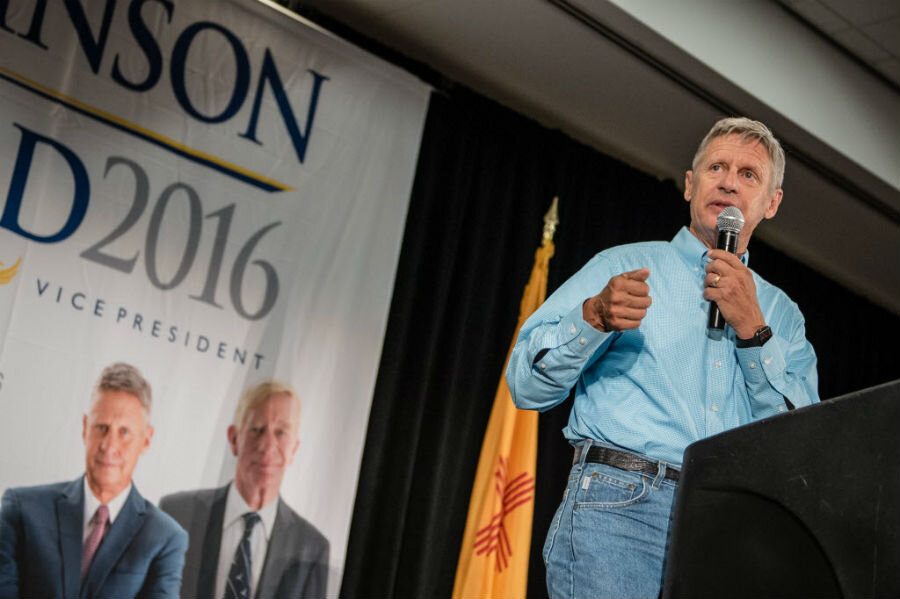How much hope for third-party presidential candidates?
Loading...
Libertarian presidential candidate Gary Johnson will appear on Ohio's ballot in November. The swing state is the latest to accept Mr. Johnson onto the ballot as a third-party alternative to Democratic presidential nominee Hillary Clinton and Republican presidential nominee Donald Trump. But if his appearance on the Ohio ballot is a victory for Johnson, it's still a relatively small one compared with the challenges that lie ahead.
Thirty-three states currently recognize the Libertarian party on their ballots, according to Ballotpedia, while 21 recognize the Green Party. The right-wing Constitution Party is recognized in 15 states.
It was a difficult battle to get Johnson on the ticket in Ohio. The complex process required to put a third-party candidate on the Ohio ballot highlights the pitfalls and challenges third-party candidates face. The "winner-take-all" US electoral system usually "reward[s] strong, larger parties while penalizing weak, smaller parties," according to Ballotpedia.
In Ohio, like many states, Libertarians have not received enough support for formal ballot recognition. The state does, however, allow independent candidates to run on the ballot, so the party submitted paperwork to have a Libertarian candidate appear on the ballot as an independent. But when the time came to submit the paperwork, the Libertarian convention had not officially chosen a candidate yet.
Charlie Earl, a Libertarian Party member who had run unsuccessful campaigns for Ohio governor and secretary of state, was put on the ballot instead. According to Cincinnati.com, Mr. Earl was to serve as a placeholder until the necessary paperwork went through to change Earl's name to Johnson.
Despite some concerns in the party that the change would not be allowed, Ohio Secretary of State Jon Husted announced Wednesday morning that Johnson's name would appear on the ballot in Earl's place, as hoped. According to The Columbus Dispatch, Libertarians acquired 7,619 signatures calling for the name swap.
The two largest third parties in the United States are the Libertarian Party and the Green Party, respectively. The Green Party nominated Jill Stein at its presidential candidate. If the election were held at the time of polling, 10 percent of American voters would vote for Johnson and only 4 percent would vote for Ms. Stein, according to a recent poll from Pew Research Center. In the same poll, Mrs. Clinton led at 41 percent with Mr. Trump trailing at 37.
Despite the low polling, however, both Stein's and Johnson's campaigns have seen an opportunity in this presidential election. Clinton and Trump both have historically high unfavorability ratings over the course of their campaigns, as the Monitor has previously reported.
Trump's unconventional manner and controversial statements have driven away many voters who would have otherwise voted Republican. Similarly, the unexpected popularity of Sen. Bernie Sanders (I) of Vermont caused a rift in the Democratic party after Mr. Sanders was unable to secure the Democratic nomination, causing many Sanders supporters to move away from Clinton.
Both Johnson and Stein hope to capitalize on disenchanted majority parties voters in hopes that their campaigns will have a chance of facing down Clinton and Trump. Stein's official Facebook page reflected this strategy when it posted a photo in July bearing the slogan, "Reject the Lesser Evil, Fight for the Greater Good!"
But earning enough support to viably run against Trump and Clinton will not be easy.
While both Stein and Johnson have also gotten their names on the ballots in states that do not recognize their respective parties through methods like the one Johnson's campaign employed in Ohio, they will likely not appear on every ballot. Johnson is currently missing from 8 state ballots, according to the Libertarian Party's official website. Stein's campaign site says that she is missing from 15 states.
For now, the candidates' immediate goals are centered around the all-important presidential debates and the exposure the debates could bring to their campaigns.
In order for that to happen the candidates will have to overcome a major hurdle. According to the Commission on Presidential Debates (CPD) website, candidates have to appear on enough state ballots to have a mathematical possibility of winning a majority of electoral college votes, and must have the support of at least 15 percent of voters in national polls. Neither Johnson nor Stein currently have the necessary 15 percent.
Both campaigns are trying to gather enough support for the debate, and Stein's campaign has even launched an online petition for the debates to "include all Presidential candidates who have qualified for enough state ballots to be a choice for a majority of voters."
The petition is unlikely to change the CPD's policy, but both third-party candidates seem prepared to stick it out until polls close on Nov. 8.








